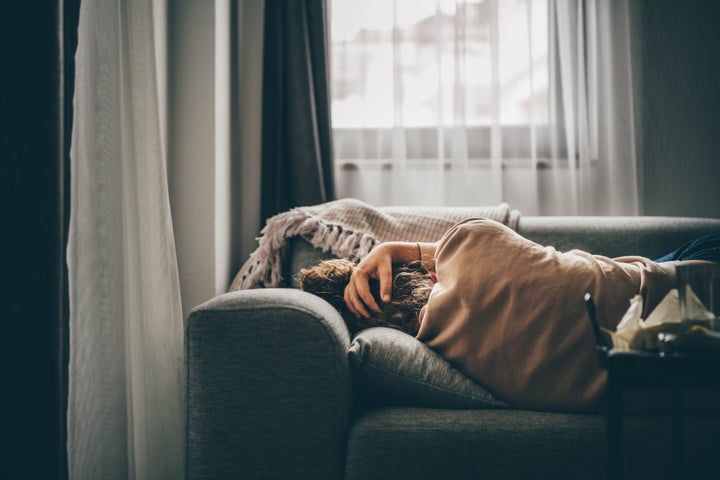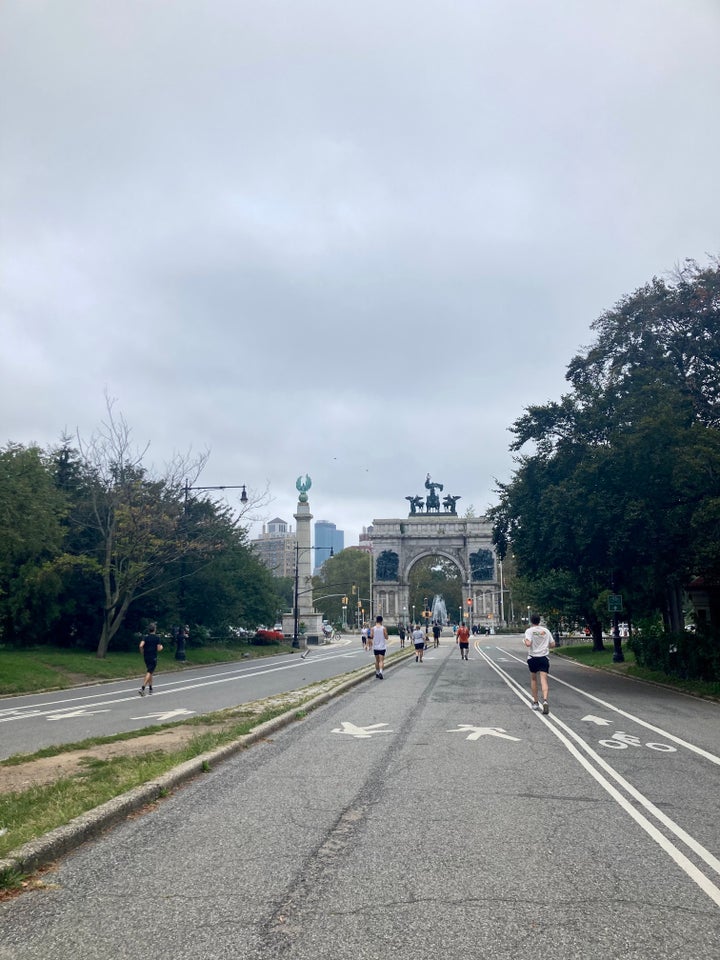
“You don’t meet the diagnostic criteria for lupus, or anything,” the rheumatologist told me, her voice unwavering through the telehealth screen. “All of these blood tests point to a young, healthy woman.”
Her words set aflame something urgent within me. Something I had dulled over two months of needle pricks, copays and hourlong holds with various doctor’s offices.
“I used to run 50 miles a week,” I said. “Now, I can hardly walk two blocks. Where are you getting healthy from?” The doctor sighed. “Come back in five months, and we’ll repeat the tests.”
Closing the telehealth window, I took stock of my surroundings. Novels and essay collections lined the wooden shelf behind me, an array of rainbow spines. Below them lay stacks of glassware. A sprawling plant wound around the doorway, its leaves bright from sun and care. Now I wondered: Should I have chosen a darker corner of the apartment? Skipped the mascara? Left my hair unwashed? I longed for my skin to hold some proof of the reality underneath it. I imagined my tan cheeks marked by splotchy rashes. My brown hair thinning and falling to clumps. Call me healthy one more time, I whispered to the empty apartment. Then, I stumbled back to bed.
***
In the beginning of 2022, I was a 26-year-old graduate student and freelance journalist. I taught an undergraduate writing course and ran six days a week. On free evenings, I’d meet friends for outdoor happy hours, readings or walks in the park. My life moved on an endless conveyer belt toward some nebulous elsewhere. If I didn’t fulfill each step of the assembly line ― the shoes laced, the bag packed, the train caught at this minute ― surely I would never make it to my destination on time.
Still, I thrived within the speed. I loved waking up before the sun and running miles on Prospect Park’s wooded trails. I loved wandering through brownstone-lined streets, past coffee shops and food co-ops, and feeling Brooklyn’s unique energy drifting through the air. I loved falling asleep with sore muscles, heavy eyes and the next day’s to-do list on my nightstand. I never planned on slowing down.
But one weekend at the end of March, I felt... slower. Something was off. The symptoms, though, felt barely distinguishable from early-spring allergies ― fatigue, sore throat, a light pressure headache. Nonetheless, I took a rapid COVID test. It was negative.
In two days, the symptoms cleared. I sent in drafts, rode the train to Manhattan, ran hill repeats in Prospect Park. Then, my roommate tested positive for COVID, and my sore throat and headache returned. For most people, this is where their COVID journey begins and ends. They post an Instagram story displaying two lines on a rapid test. They isolate for 5-10 days. Someone brings them soup. They return to work and normal life. My journey, though, had just begun. I quarantined beside my roommate, both of us vaccinated and boosted. Throughout that week, I took daily PCR tests, but all of them came back negative.
***
One week later, I awoke from a dreamless sleep. I could not get out of bed. I could not reach for my phone. A migraine had settled behind my eyes, wrapping its limbs around my ears and head, like a baby koala.
A week went by. Then another. A third. Each morning was the same. I swallowed Advil and Motrin. Sipped Pedialyte. Nibbled frozen bananas. Yogurt when I could stomach it. I stepped outside, and legs that had once run 30 miles in one day could barely walk two blocks. The sun shone, but I wished it would not. My vision blurred. My brain heaved. My head floated in some alternate universe, as if shrouded by an impenetrable screen. What word did I have for this feeling? “Brain fog” seems inadequate. “Dissociation,” still, insufficient for this all-consuming haze.
I stopped accepting freelance assignments. Twice a week I rode the train to teach. I paused while walking to the station, lightheaded, and grabbed hold of a tree or light post. I would resume walking when the dizziness slowed. I could fake it enough in front of a classroom ― until the word I needed would linger just beyond my grasp, the fog in my brain closing in and shrouding it. Then, I would be left, drowning in my students’ stares and my own stutter and my talking hands. I would choose a nondescript substitute for the word I meant to say — “things” instead of “devices,” “movement” instead of “rapidity,” “things” again. Class would end. The relief. Then, the walking, the breathing. The ground under my feet, still there, still firm, feel it. The numbness of my hands and feet. Then pausing, then sitting on a bench in the West Village. I’d close my eyes until the dizziness slowed. Throughout my life, I could barely manage to get eight hours of sleep each night. Now I was sleeping 12 hours and it was not enough.
After three weeks passed, I woke up feeling slightly energized ― not like myself, but a version of myself. One that could roll out of bed near-instantaneously and walk around the apartment without feeling lightheaded. A self that craved, most of all, to run. So, I laced up my shoes and entered the state that had always felt natural to me. But it was not natural. Not this time. Now, my legs felt simultaneously leaded and weak. I shuffled along at a speed slower than any I had seen or felt before. After 20 minutes, I gave up.

That afternoon, I sat at my desk and tried to work, but my heart began beating intensely ― palpitations that pulled at my mind and the words on the screen until I could barely comprehend them. All I knew was this beating.
In the emergency room, a technician took my pulse and performed an EKG. A doctor called for a chest X-ray. “All normal,” she reported upon entering my hospital room.
“I know you feel awful,” she told me, leaning forward until her eyes were level with mine. “But you look really pretty.” I bit my lip. Somehow, it moved in a thank you formation ― words that surely could not have been mine.
Afterward I stumbled home, head dizzy, legs shaky, and a hospital bracelet clinking on my left wrist. Every block or so I’d pause and crouch down on the sidewalk. There, among trash bags and shoe grime, I’d close my eyes.
***
My doctor performed a plethora of tests — white and red blood cell counts, hepatitis, mono, Lyme, autoimmune antibodies, a check of all my vitamin levels. All normal. Healthy. I had a high COVID antibody count, but only from the spike protein, which is indistinguishable between vaccine and infection. Still, I could not shake the timeline of this illness. The knowledge that one week, I was a healthy 26-year-old woman and the next, I was exposed to COVID and developed lingering, disparate symptoms. Could it be mere coincidence? Since my doctor could not prove a connection to COVID, he suggested we treat this as an undiagnosed illness. What followed were months of visits to doctor’s offices and hundreds of tests.
To be entrenched in the medical system is to watch oneself fragment into simpler forms. I was a body ― flesh and blood, diffuse pain, every fleeting sensation and the thoughts that attended them. Now, I was a vial of blood. Many vials of blood. A plastic container of urine. “Which arm? Left or right?” Left. “OK with needles? OK with blood?” Nod, yes. Tourniquet on left arm. Wet sensation in the crook. Small prick. “Are you OK?” The technician’s voice surprised me. I jerked my head to the left. Only then did I realize that I had been staring straight ahead, eyes unblinking, still. The technician was nothing but a mass moving around me. A blob of matter ― Barney-purple scrubs, blue sweatshirt. “Yes, fine.” “Yes, OK.” Although, I meant: not fine. I meant: not OK. I meant: This is my fourth round of testing in four weeks. Why am I still being asked if needles scare me?
There was a neurologist. A rheumatologist. A heart monitor stuck to my chest. EEG electrodes glued to my scalp. I lay in an MRI tube as a technician took an image of my brain. Another took an image of my spine. At a cardiologist’s office, a lady with a thick Long Island accent took pictures of my heart. I sat in a chair, my legs propped, as a young man stuck electrodes to my head. All normal. All healthy.
“I am getting really concerned,” I messaged my doctor after two months. “Do you think this could be Lyme?” I could no longer feel my feet or my right arm. My neurologic symptoms had become so debilitating that, on the worst days, I felt as if I had a terrible flu, and that simultaneously, as if someone had slipped a tab of LSD under my tongue while I slept.
I read accounts of individuals who were diagnosed with neurologic Lyme disease, despite negative tests. “I don’t think you have Lyme,” my doctor wrote back. Desperate, I still booked an appointment with a Lyme specialist. He prescribed me a round of doxycycline and Malarone, for a potential co-occurring tick infection ― a diagnosis he considered “supported,” but not certain. After six weeks of treatment, I felt only worse.
***
As a young child, I favored bedtime stories where protagonists embarked on journeys, meeting new characters at every turn. In storybooks, this seems to be a trend: a pile-on effect. Alice follows the White Rabbit down a hole to meet the Mouse, the Caterpillar, the Cheshire Cat and the Queen. The baby bird leaves the nest in search of his mother, and finds various contenders: a rooster, a dog, a car, an airplane. Tucked beside my mother and sister at bedtime, I would delight in each character’s dramatic portrayal. My mother’s voice would change in timbre with each one ― the fast-speaking rabbit, the terse and angry caterpillar.
Now, I imagined my medical practitioners as caricatures of themselves, too. The Lyme specialist wore thick glasses and mumbled his words; the EEG technician laughed boisterously; the sonogram technician spoke with gentle concern, waves of care crashing over me with every word. Perhaps it lessened the sting ― the cruelty of this mysterious illness ― to imagine doctors as illustrated characters, as if my journey with them were mere fantasy, mere storybook.
“I’d lurk in the comments section, taking screenshots of any stories that resembled mine. I found anecdotal evidence: Other patients had been exposed to the virus and never tested posted, but developed long-COVID symptoms, nonetheless. Suddenly, I was not just some lone storybook character in a fantasy world.”
Decades removed from bedtime stories, I rode the subway to one doctor’s office and the Metro North train line to the next. I opened the telehealth window for a follow-up. I walked slowly to the Quest lab for testing, my legs weaker with each step. Normal, the characters told me. Healthy, when the lab tests returned. I had not felt so young and helpless since my storybook days. I had also never felt so old.
***
Three months into my illness, I went to stay with my parents in their home just north of Chicago. Here, I sought yet another opinion, this time from a doctor at Northwestern. He reviewed all my test results and conducted a thorough physical exam. “You fit the profile of my long-COVID patients very well,” he said. “Your symptoms, and the timeline, all point to post-COVID.” And yet, the kicker: I still had no test evidence. I had never gotten a positive PCR result. I had a high antibody count, but only from the spike protein. Was long COVID proven? No. But, was it likely I had another long-lasting illness? One that emerged at the same time I was exposed to COVID? Also, no.
My diagnosis felt like a carnival raffle, a statistical game. Likely, unlikely. When the music stopped playing, my number was never called. So, I sought out others’ stories. In early June, science journalist Melinda Wenner Moyer wrote that her daughter, son and husband all developed COVID symptoms at the same time. The family took COVID tests daily for seven days, but only her daughter tested positive. It’s possible, Wenner Moyer writes, for a vaccinated person to catch COVID-19, but for their immune system to fend off the virus so well that a test cannot detect it. Since March, I felt buried by an unliftable blanket, heavier with every passing day. But now a corner had unfolded. There I was: ever so slightly ― seen.
Now, I set Google alerts for “long COVID” and “long COVID treatment.” I joined the Body Politic support group, a patient-led organization breaking down barriers to post-COVID care. I followed Instagram pages and Twitter hashtags. I reactivated my Facebook account and joined additional long-COVID groups. There, I’d lurk in the comments section, taking screenshots of any stories that resembled mine. I found anecdotal evidence: Other patients had been exposed to the virus and never tested posted, but developed long-COVID symptoms, nonetheless. Suddenly, I was not just some lone storybook character in a fantasy world.
***
My guess is that there are countless individuals who have long COVID, but who lack the evidence necessary to access care. Still, I must be clear: this is not their story. This is my story, and the facts of my story are this: I am a 26-year-old white woman. I have a flexible job. I have good health insurance. I have friends who check in constantly. I have family that is willing and able to help pay for my medical costs ― I could not have afforded this care without them. I saw six doctors, underwent hundreds of tests, and paid thousands of dollars out-of-network before receiving a post-COVID diagnosis. Still, without a positive COVID test, I don’t fit the criteria for most medical trials or long-COVID programs. So, compiling a team of trusted practitioners requires incessant research; back-and-forth calls with doctor’s offices, my student health center and my insurance company; and hours on hold. Most people do not have the resources to take these steps.
Importantly, women and nonbinary people face higher instances of medical gaslighting and delayed diagnosis than men do. This is especially true for low-income, trans, Black and Hispanic women, as well as nonbinary folks. These are the same groups that, most often, lack the resources to pay for and seek adequate treatment. If mine is just one story, I wonder, what facts do the other stories hold? What words of dismissal have been uttered by doctors? What jobs have been lost? How many mental health conditions have emerged? What unsafe, exploratory treatments have people turned to when unable to access adequate care? My guess is that many people’s stories bear a resemblance to mine ― and yet their paths hold deeper divots and more treacherous peaks.
Further, my story should not be interpreted as a critique of any one doctor or medical practice. I am grateful for the many doctors who worked with me. I am indebted to modern-day medicine. But I am curious about the limits of the medical system when it comes to invisible illness ― what it means to look like a “young, healthy woman,” but to feel quite ill.
***
Currently, no days are good days. Many mornings, I awake with a migraine; the right side of my body falls numb; and I walk sluggishly, around the block, in an overwhelming fog. On these days, I cannot shake the thought that something alien lingers inside me. This virus is new and its mechanisms are unclear. But it is sly; it wears a heavy armor. It yields a piercing sword. In my darkest hours, I call my sister in tears. I say, “There’s something alien inside my brain.” I say, “There’s something deeply wrong with me, and no one will help!” When I awake ― brain throbbing, exhausted but unable to achieve restful sleep ― I will scribble feverishly in a notebook. I will search for the words to convey this. I will not find the words to convey this. Again and again, I will fail.
There are periods when I feel slightly improved ― for one day, three days, maybe four. I know better than to interpret these days as anything more than what they are. They are not prophecies. I do not know whether this better will linger, or if bad will take its place. I have begun to relent to the details of a calmer life. The slow breakfast. The hour when the sun is just low enough in the morning that I might sit outside and read. I take my time to stand, to feel the cool floor tiles under my bare feet. To let the dizziness subside. I measure. Tablespoons of coffee grounds. Hours spent awake. Mornings passed without a migraine. Blocks trudged with heavy legs. It is not willingly that l relent to this slower life. It is with necessity. Knowing that it’s only through the slowing that I may, one day, exit this tunnel. Only through the slowing that I may, one day, return to the speed that pulls me relentlessly on the other side.
Emma Zimmerman is a writer and freelance journalist. Her journalism has appeared in Outside, Runner’s World and Women’s Running, among other publications. Her literary nonfiction has received honors from Lighthouse Writers’ Workshop and PRISM International. She is currently completing her MFA in nonfiction writing at NYU, and she lives in Brooklyn, New York.
Do you have a compelling personal story you’d like to see published on HuffPost? Find out what we’re looking for here and send us a pitch.
